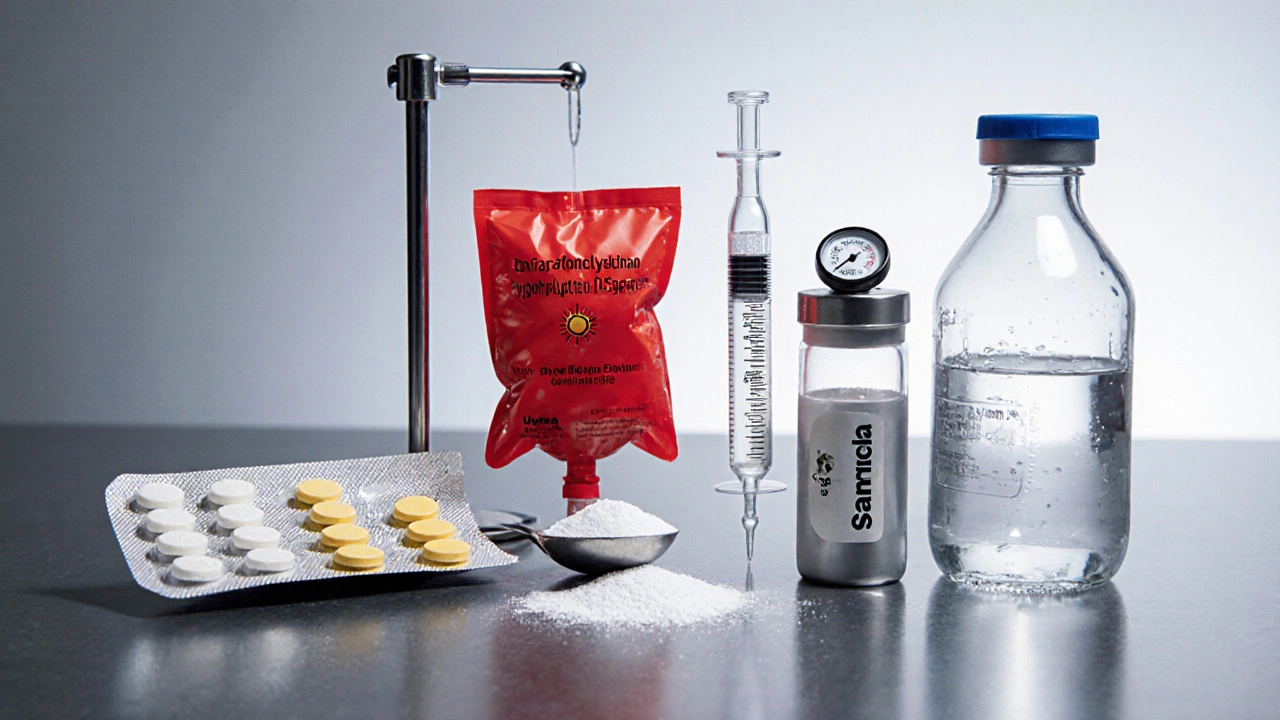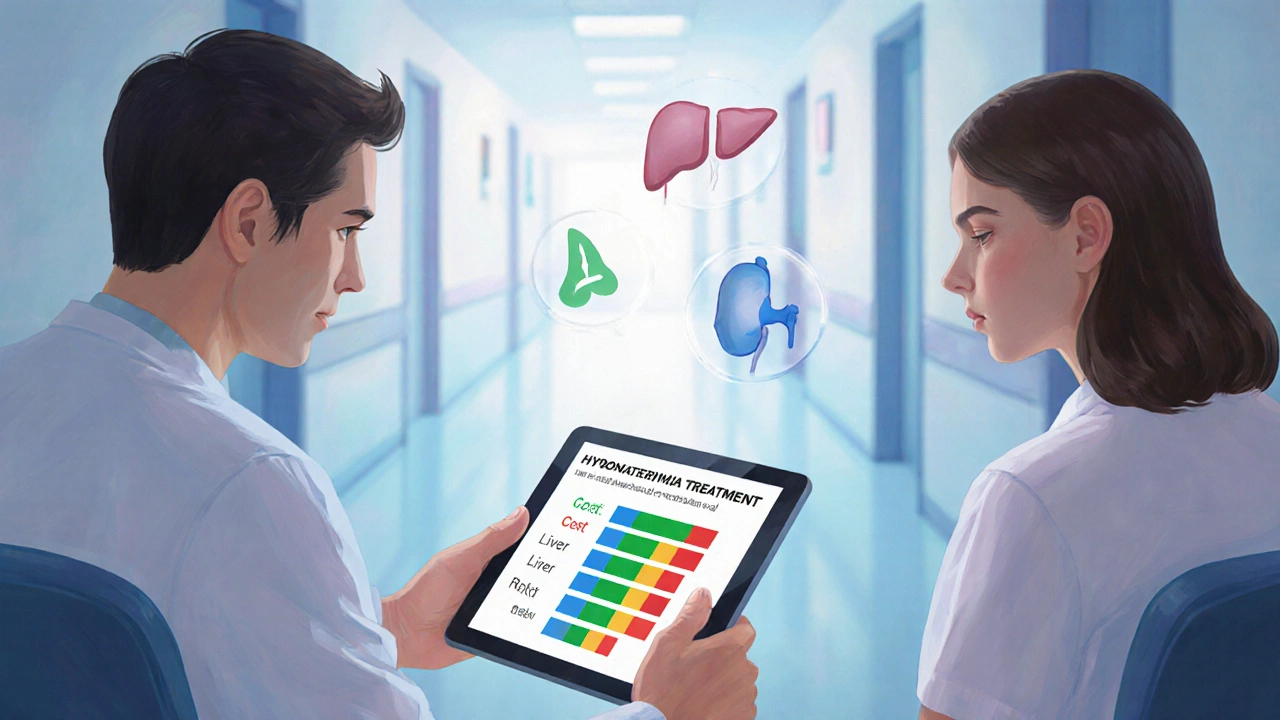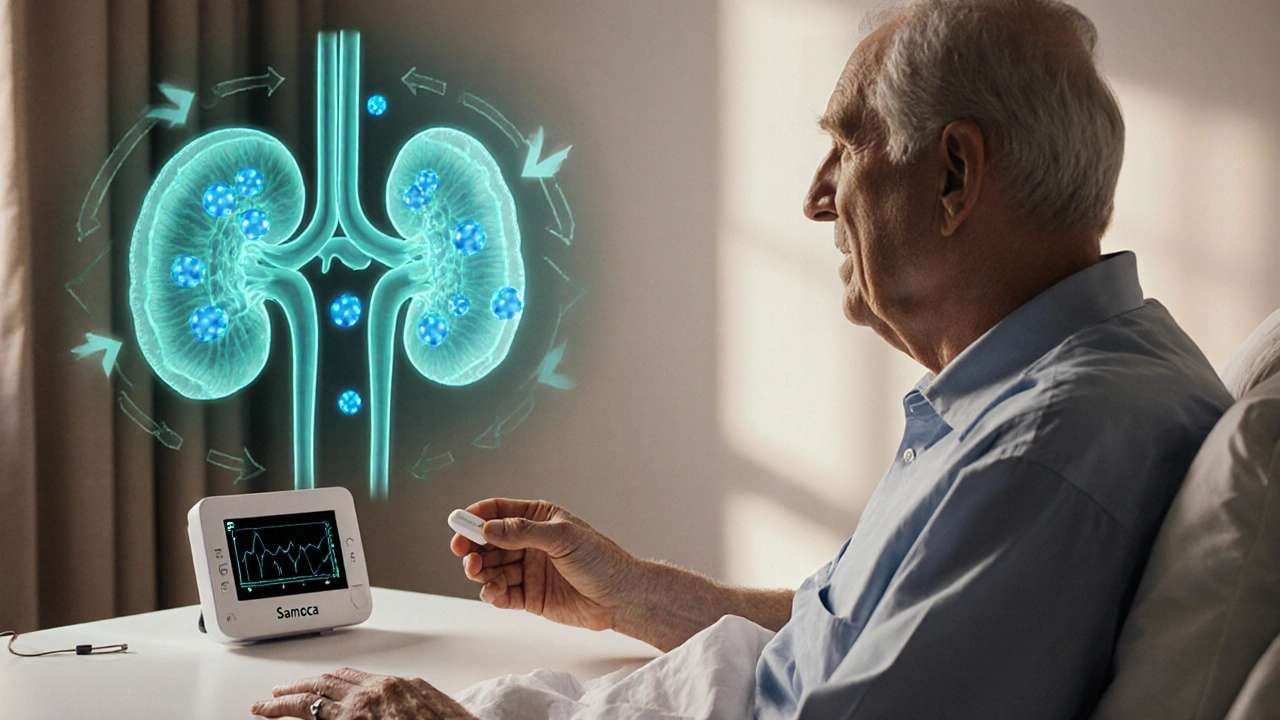Hyponatremia Treatment Decision Tool
If you're weighing Samsca against other hyponatremia options, you’re probably wondering which drug will correct low sodium safely, fit your lifestyle, and avoid pricey side‑effects. Below you’ll get a clear rundown of how Samsca works, which alternatives exist, and a side‑by‑side comparison to help you decide.
What is Samsca (Tolvaptan)?
Samsca is a vasopressin V2‑receptor antagonist (generic name tolvaptan) that encourages the kidneys to dump free water without losing sodium. By blocking the hormone arginine‑vasopressin, it raises serum sodium usually within 24‑48hours.
Key attributes:
- Oral tablet, 15mg or 30mg strength.
- Approved by the FDA for hyponatremia caused by SIADH, heart failure, and cirrhosis.
- Typical maintenance dose: 15mg daily, titrated up to 60mg if needed.
- Requires baseline and weekly liver‑function monitoring for the first month.
Clinical data from the SALT‑1 and SALT‑2 trials showed an average increase of 5-7mmol/L in serum sodium after 30days, with a 30% chance of over‑correction if fluid intake isn’t restricted.
Why consider alternatives?
Not everyone can take Samsca. Liver toxicity, high cost, or a need for rapid correction pushes clinicians toward other strategies. Below are the most frequently used alternatives, each with a distinct mechanism and practical profile.
Demeclocycline
Demeclocycline is a tetracycline antibiotic that indirectly impairs the collecting‑duct response to vasopressin. It’s taken orally, usually 300mg twice daily.
Pros: cheap, no need for daily labs after the first week.
Cons: nephrotoxicity, photosensitivity, and slower onset (3‑5days). Not recommended in patients with pre‑existing kidney disease.
Conivaptan
Conivaptan is an IV V1A/V2‑receptor antagonist used for acute correction in the ICU. Doses start at 20mg bolus, then a 20mg/hour infusion.
Pros: rapid effect within hours, useful for severe symptomatic hyponatremia.
Cons: requires hospital stay, higher cost, and potential for hypotension.
Hypertonic Saline (3% NaCl)
Hypertonic saline raises serum sodium directly by delivering concentrated sodium chloride intravenously.
Pros: fastest way to raise sodium, ideal for emergencies.
Cons: risk of osmotic demyelination if corrected >8mmol/L per 24h, must be administered under strict monitoring.
Fluid Restriction
Fluid restriction limits daily intake to 800‑1000mL, forcing the body to excrete water.
Pros: no medication, zero cost.
Cons: often ineffective for severe SIADH, difficult adherence, may cause dehydration.
Urea
Urea works as an osmotic diuretic, increasing free water clearance when taken orally (typically 15‑30g per day divided doses).
Pros: inexpensive, can be combined with fluid restriction.
Cons: unpleasant taste, gastrointestinal upset, limited availability in some regions.
Lixivaptan (Investigational)
Lixivaptan is a newer oral V2‑antagonist still awaiting regulatory approval. Early phase‑II data suggest similar efficacy to tolvaptan with a potentially better liver‑safety profile.
Pros: promising safety, once‑daily dosing.
Cons: not yet on the market, cost unknown.

Side‑by‑Side Comparison
| Alternative | Mechanism | Route & Dosing | FDA Status | Typical Indications | Main Side Effects | Monitoring Needs |
|---|---|---|---|---|---|---|
| Samsca (Tolvaptan) | V2‑receptor antagonist | Oral, 15‑60mg daily | Approved | SIADH, CHF, Cirrhosis | Liver enzyme elevation, thirst, polyuria | Baseline & weekly LFTs, serum Na checks |
| Demeclocycline | Impair V2 signaling via renal tubular effect | Oral, 300mg BID | Approved (off‑label for hyponatremia) | Chronic SIADH | Nephrotoxicity, photosensitivity | Renal function, serum Na weekly |
| Conivaptan | V1A/V2 antagonist | IV bolus 20mg → 20mg/hr infusion | Approved (IV only) | Acute severe hyponatremia | Hypotension, infusion reactions | Continuous BP & Na monitoring |
| Hypertonic Saline | Direct NaCl delivery | IV 3% NaCl, rate controlled | Approved | Emergency correction | Osmotic demyelination risk | Serum Na every 2‑4h |
| Fluid Restriction | Limits free water intake | Oral, < 1L/day | Standard of care | Mild‑moderate SIADH | Dehydration, poor adherence | Weight & electrolytes daily |
| Urea | Osmotic diuretic | Oral, 15‑30g/day split | Approved in EU, off‑label US | Chronic SIADH | GI upset, taste issues | Serum Na, renal function weekly |
| Lixivaptan (Investigational) | Selective V2 antagonist | Oral, once daily (dose TBD) | Not approved yet | Potential future hyponatremia treatment | Unknown, early data suggest low liver impact | Anticipated LFT monitoring |
How to Choose the Right Option
Decision‑making boils down to three factors: speed of correction needed, safety profile, and patient‑specific constraints.
- Urgent, symptomatic hyponatremia - reach for IV options (conivaptan or hypertonic saline). They act in minutes to hours.
- Chronic, modest sodium deficit - oral agents like Samsca or demeclocycline work well, provided liver or kidney function is acceptable.
- Cost‑sensitive settings - fluid restriction, urea, or demeclocycline are the cheapest, though adherence can be a hurdle.
Don’t forget comorbidities. Patients with chronic liver disease are at higher risk of tolvaptan‑related hepatotoxicity, so alternatives with less hepatic impact (demeclocycline, urea) may be safer. Those with impaired renal function should avoid demeclocycline and watch for urea‑related electrolyte shifts.
Practical Tips for Using Samsca
Even if you decide Samsca is the best fit, following a few practical steps reduces complications:
- Obtain baseline liver enzymes (AST, ALT, bilirubin) and serum sodium.
- Start at 15mg once daily; wait 24h before checking sodium.
- If sodium rises >6mmol/L in the first 24h, consider dose reduction or temporary hold.
- Maintain a fluid intake limit of 1.5L/day to avoid over‑correction.
- Repeat LFTs at week1, week2, and month1; thereafter every 3months if stable.
Patients often report increased thirst and frequent urination; counseling about adequate water intake (but within the fluid limit) helps them stay comfortable.

When to Switch or Add an Adjunct
If sodium plateaus below target after 4weeks on the maximum tolerated dose, consider adding a second line strategy instead of pushing the dose higher. Common combos include:
- Samsca + modest fluid restriction (800mL/day) - often nudges sodium up an extra 2‑3mmol/L.
- Demeclocycline after tolvaptan discontinuation if liver enzymes climb.
- Urea as a rescue when oral V2 antagonists are stopped abruptly.
Always reassess kidney function before layering diuretics, as the risk of acute kidney injury rises sharply.
Frequently Asked Questions
Can I take Samsca if I have liver disease?
Samsca carries a boxed warning for hepatotoxicity. If you have chronic liver disease, doctors usually start at the lowest dose, monitor liver enzymes weekly, and may prefer demeclocycline or urea instead.
How quickly does Samsca raise sodium?
Most patients see a 4‑6mmol/L rise within the first 24hours, with a plateau around 7‑10mmol/L after two weeks if dosing is stable.
Is demeclocycline still used despite being an antibiotic?
Yes, because its off‑label effect on aquaporin‑2 channels makes it a cheap oral option for chronic SIADH. Physicians watch kidney function closely.
When is hypertonic saline preferred over oral agents?
In emergencies-severe neurological symptoms, seizures, or very low sodium (<120mmol/L). It can raise sodium by 4‑6mmol/L in a few hours, buying time for definitive therapy.
What monitoring is required for urea therapy?
Check serum sodium daily for the first week, renal function weekly, and watch for gastrointestinal upset. No liver tests are needed.
Bottom Line
Choosing between Samsca and its alternatives isn’t a one‑size‑fits‑all decision. If you need a fast, controllable rise and can manage weekly labs, Samsca is often the first choice. When cost, liver safety, or the need for a purely oral regimen dominate, demeclocycline, urea, or fluid restriction may make more sense. Always pair the drug choice with close monitoring-especially of sodium trends and organ function-to keep the correction safe and sustainable.


Jarrod Benson
October 12, 2025 AT 06:09Alright folks, let’s dive deep into the world of hyponatremia treatments and why Samsca shines like a beacon for many patients.
First off, the oral administration is a game‑changer compared to the tedious IV setups of conivaptan or hypertonic saline.
Second, the mechanism of blocking V2 receptors means you get free‑water clearance without dumping sodium, which is exactly what we want in SIADH.
Third, the dose titration from 15 mg up to 60 mg gives clinicians flexibility to tailor therapy to each individual’s response.
Fourth, the clinical trials (SALT‑1 and SALT‑2) showed a consistent 5‑7 mmol/L rise in serum sodium within the first month, which is impressive for a chronic condition.
Fifth, the side‑effect profile is relatively benign – mainly thirst and polyuria, both manageable with patient education.
Sixth, the monitoring requirements, while present (weekly LFTs for the first month), are not as burdensome as daily labs needed for IV therapies.
Seventh, the cost, though higher than fluid restriction, often gets covered by insurance for appropriate indications, making it accessible for many.
Eighth, the drug’s ability to be combined with modest fluid restriction can push those stubborn patients over the target sodium levels.
Ninth, real‑world data suggest that patients on Samsca have better quality‑of‑life scores because they avoid hospital stays.
Tenth, the risk of over‑correction can be mitigated by strict fluid intake limits – a simple patient‑centered measure.
Eleventh, for patients with liver disease, starting low and monitoring closely can still make Samsca a viable option when other drugs are contraindicated.
Twelfth, alternatives like demeclocycline carry nephrotoxicity risks, and urea’s taste is often a deal‑breaker.
Thirteenth, hypertonic saline is lifesaving in emergencies but is nowhere near a long‑term solution.
Fourteenth, conivaptan’s need for ICU monitoring makes it impractical for most outpatient scenarios.
Fifteenth, the overall benefit‑risk ratio of Samsca makes it a front‑line oral therapy for chronic hyponatremia when liver and kidney function allow.
Sixteenth, remember to educate patients about the importance of staying hydrated within the 1.5 L/day limit to avoid rapid shifts.
Liz .
October 15, 2025 AT 17:29hey this post is super helpful it breaks down each option without all the medical jargon i love that you can actually see when to use iv stuff vs an oral pill and the tables are easy to read
tom tatomi
October 19, 2025 AT 04:49while the overview is thorough many clinicians overlook the fact that tolvaptan isn’t a silver bullet; patient adherence to fluid limits often fails and you end up with over‑correction anyway.
Ajayi samson
October 22, 2025 AT 16:09Samsca’s touted benefits are blown out of proportion – the liver toxicity warning isn’t a footnote, it’s a real barrier for a large chunk of the patient population, especially those with underlying cirrhosis. The need for weekly LFTs adds a logistical nightmare for clinics with limited resources. Moreover, the price tag can be prohibitive; many insurers still balk at covering a drug that requires such intense monitoring. In contrast, demeclocycline, though older, is cheap and requires far less lab work. Urea, while unpalatable, avoids hepatic concerns entirely. The article glosses over these practical downsides and pushes a biased narrative favoring the newest drug.
Lief Larson
October 26, 2025 AT 03:29great summary but i think many patients will just stick with fluid restriction because it costs nothing
Julia Grace
October 29, 2025 AT 14:49Hey there! I wanted to add a quick note – if you’re worried about the taste of urea, try mixing it with a flavored beverage to mask the bitterness. Also, when starting Samsca, keep a close eye on your water intake – a good rule of thumb is no more than 1.5 L per day, otherwise you might see that dreaded rapid rise in sodium. For those with mild liver issues, a starting dose of 15 mg is usually safe and you can bump it up slowly while checking your LFTs. If you ever feel extra thirsty, that’s normal, just sip water within your limit. And don’t forget – the most common side effect is increased urination, so you might have to pee more often, but it’s usually not harmful. Overall, balancing the fluid restriction with the medication works great for most folks.
Sadie Bell
November 2, 2025 AT 02:09Checking off the right steps can make a huge difference, keep your eye on those labs and stay consistent with your dosing schedule.
Michael Daun
November 5, 2025 AT 13:29Remember folks that partnering with a dietitian can help you meet that fluid restriction without feeling like you’re choking – they can suggest low‑sodium soups or broth that still keep you hydrated. Also, setting a reminder on your phone for your daily dose can keep you from missing a pill, especially when you’re busy.
William Goodwin
November 9, 2025 AT 00:49💡Let’s get dramatic for a sec – imagine a world where every hyponatremia patient walks out of the hospital with a prescription for a tiny tablet that quietly does its job while you binge‑watch your favorite series. That’s Samsca, the unsung hero of electrolyte balance! 🎭 Yet, don’t forget the villains: pricey labs, the myth of “no‑drink” anxiety, and that occasional liver warning. 🎭 Balance is key – sprinkle in a dash of fluid restriction, a pinch of monitoring, and you’ve got a recipe for success. 🚀
Isha Bansal
November 12, 2025 AT 12:09While reviewing the data presented, it becomes evident that the author’s omission of comprehensive comparative statistics is not only a scholarly oversight but also a disservice to clinicians seeking evidence‑based guidance. The lack of proper citation formatting, inconsistent use of units, and occasional typographical errors further undermine the credibility of the piece. Moreover, the narrative displays an unsettling bias toward pharmaceutical solutions, neglecting the pragmatic value of traditional approaches that have served patients across diverse health systems worldwide. In the spirit of scientific rigor, one must demand precise language, balanced perspectives, and a commitment to the highest editorial standards.
Ken Elelegwu
November 15, 2025 AT 23:29Indeed, the discourse surrounding hyponatremia therapeutics often veers into hyperbole; a nuanced appreciation of pharmacodynamics alongside patient‑centred considerations is paramount. While Samsca offers a sophisticated mechanism, its deployment must be tempered by vigilant hepatic surveillance and socioeconomic realities. In this light, a judicious blend of evidence‑based pharmacology and accessible interventions such as fluid restriction remains the cornerstone of holistic care.